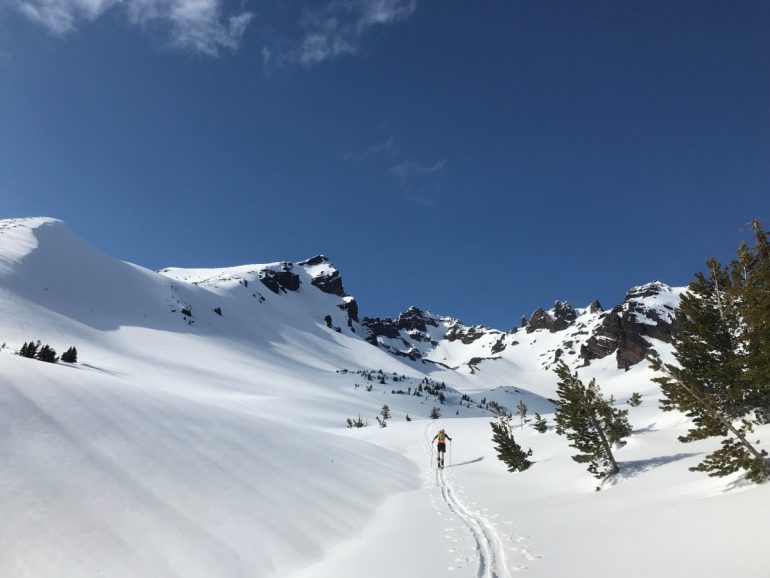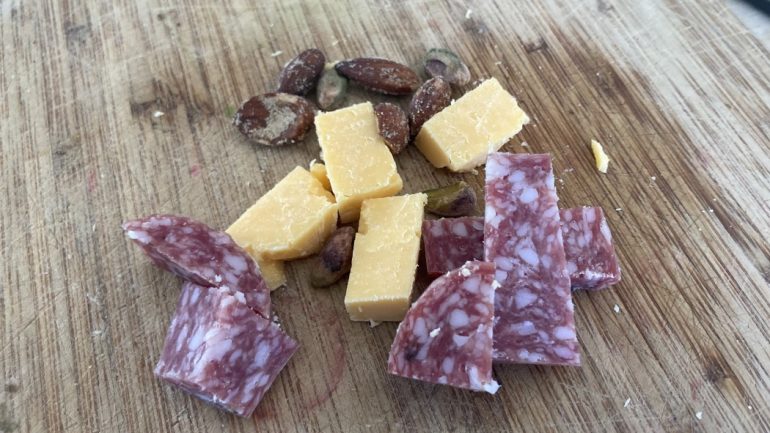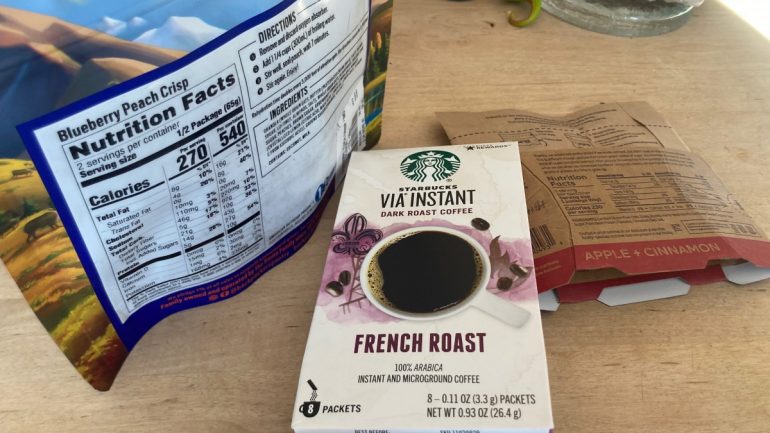
Bigger days this time of year require proper fueling; meaning food and hydration are key.
“Never underestimate the impact of a single Snickers bar on your physical and mental well-being.”
I’ve adopted this adage as my mantra for most mountain outings by foot, ski, or wheel for the past many years with general success. Still, I work more with athletes at all levels chasing objectives in the mountains, I’ve found that going a bit deeper on specifics for fueling can be a helpful tool in supporting success. With the caveat that every athlete is different regarding diet, caloric need, fitness level, and preference for jam or jelly, what follows is a brief survey on fueling tips and tricks for ski touring.
Summit Lunch or Snacking En Route?
Like many of the best lessons I’ve learned in my adult life, much of my strategies on fueling during long efforts I cribbed from my wife Alison. A long-time ultrarunner, Alison gradually developed an understanding of the “opportunistic raccoon”-style of fueling during big efforts, maximizing intake throughout the day to “train the gut” to absorb ingested calories and not shut down with GI distress. I come from a Nordic racing background where events (I was a sprinter, predominantly) didn’t last longer than several minutes, and even in the marathons, “fueling” meant a quick splash of sport drink in your face at high speeds. On our first few long runs together, I would gleefully gallop ahead like a deer, blithely ignoring any requirement to eat a gel or bar or other rabbit food offering from the sports nutrition world. She, meanwhile, would methodically eat every 45-60min, slowly “sipping” gels or nibbling sports chews quietly on hiking climbs and brief rest stops. “Poppycock!” I would proclaim when she suggested I eat. “I’m not hungry!” Then, by around three hours in, slight hunger knocks would amplify to all-out bonk warfare in my body— my energy sliding away like a spring glide avalanche and I would be left blearily scratching at the bottom of my too-small running pouch for a morsel of food to re-animate me. I finally learned that waiting until the hunger was apparent was the wrong strategy.

Beginning to mix up a higher calorie snack bag for a day out.
Fueling for optimal performance and subsequent recovery should be viewed like any other preparation for your objective: it must be practiced and trained to work. Set a goal for yourself to eat every 30-45 minutes during a ski tour regardless of hunger. This doesn’t mean whole PB&Js; try the practice of nursing an energy gel or sport drink, or breaking what might be a larger meal into small bites, like a tortilla-avocado-turkey rollup cut into small sections and eaten over the course of a couple of hours. In this way, your gut gets used to regular infusions of calories and, in turn, improves its ability to absorb carbohydrates at a faster rate and in higher quantity. There’s lots of science on this that we won’t dive into here, but if you’re interested, you can search “carbohydrate absorption rate for endurance athletes” and find peer-reviewed studies suggesting absorption rates in trained athletes of 90+g/hr!
In addition to improved and sustained performance, there are other reasons why regular fueling should be a preferred strategy to the meal-based approach on a long tour. Most notably, regular fueling ensures a consistent and steady supply of energy both for your moving demands (i.e. skinning, skiing), and the cognitive ones. Ski touring involves a high degree of mental and situational awareness, identifying hazards, reassessing route plan and group dynamics, snow quality, and all the rest. The brain runs on glycogen, the body’s stored form of carbohydrates. If you’re running a deficit due either to over-exertion or under-fueling, your capacity for decision-making and critical thinking reduces dramatically and increases your risk factors. Fuel not only to top out that steep booter; but fuel also for the (hopefully unlikely) instance that you need to level up your cerebral function to adapt to the unexpected.

Especially on multi-day trips, but on single day outings as well, it’s valuable to think of yourself as the aforementioned “opportunistic raccoon in a dumpster,” carrying an array of snacks and foods that are sure to keep you interested in eating even after a few days on the go.
What about a multi-day tour? While on the surface it seems reasonable that you’re just linking multiple single-day tours in a row, it changes a bit with the types of food you can reasonably carry in a pack, and whether they’ll still be palatable on day two or three, etc. Especially on multi-day trips, but on single day outings as well, it’s valuable to think of yourself as the aforementioned “opportunistic raccoon in a dumpster,” carrying an array of snacks and foods that are sure to keep you interested in eating even after a few days on the go. On top of that, consider foods that are high in satiety (sense of filling you up) like nuts, cheese, peanut butter, etc. Dehydrated meals are fast, lightweight and calorie-dense, and you can augment them with extra oils or cheese that you carry along to boost the value even further.
Some athletes will carry only sport food (bars, chews, gels) to cover their energy demand during a tour. Many alpinists, ultrarunners and ski-mountaineers swear by the minimalist approach: count the number of hours you plan to be out, multiply that by X number of gels, then get on the horse and ride. A friend of mine swears by maple syrup as his only fuel for a mountainous 50km running race, and another relies solely on caffeinated nut butters for 40+ mile trail runs.
Especially on multi-day trips, but on single day outings as well, it’s valuable to think of yourself as the aforementioned “opportunistic raccoon in a dumpster,” carrying an array of snacks and foods that are sure to keep you interested in eating even after a few days on the go.
This is fine, but it’s worth considering what happens if your stomach decides to become enemies with those processed goos you’ve been sucking down for the last five hours? Bringing an array of foods you want to eat will help buffer against GI shutdown and keep you interested even as fatigue sets in. It only takes one look at a typical 100-mile running race aid station’s buffet of offerings to know that when deep in an endurance effort, folks like to have a selection of sweet, salty, crunchy, and chewy foods to choose from, not knowing what they’ll be hungry for (if anything) after countless miles of grinding. In so many cases, having “real food” with you (stuff you’d consider eating at home: sandwiches, wraps, fruit) will provide you that diversity such that you’re sure to have something you want to eat. I like to keep my food in a ditty bag in my pack, and I keep it replenished with an array of fun-size candy bars and small treats as backups in case nothing else looks appetizing.

Calorie counting and morning hydration are taken into consideration here.
Hydration
More important and complementary to calorie intake, proper hydration (especially in springtime sun and warmth) spells the difference between a sweated-out sufferfest and a sustained good time on a corn harvest. Carrying ample water (ideally 12-20oz per hour, depending on conditions) gets more complicated on multi-day outings. The most common ways to manage proper hydration on multi-day outings is to combine melting snow (fuel-intensive) and lightweight in-line water filters (provided you can find standing water sources). In either case, it requires deliberate pauses in your movement to focus on topping up stores, drinking your fill, and accumulating enough for that day’s meal along with the next morning’s brew and morning skiing. Thinking quantitatively and keeping track of your intake will help ensure you don’t run out or face challenges in dehydration later in the day.
What follows are two tour scenarios and example nutrition/meal plans to consider. Use these as templates to build your own fueling protocols and include your favorite foods and snacks to dial it in.
The Single-Day Tour:
*Start with about 150- 200cal + 12-16oz of water per hour
– 20oz black tea or other caffeinated beverage
– 1 L of plain water or sport drink
– 2x sandwiches or wraps:
o PB/J
o Salami + cheese
o Avocado, cream cheese and turkey
– A couple of cookies or a pastry from the local bakery
– 300-500 calories of bars, gels and chews for quick calories
The Multi-Day Tour:
*Same calorie and hydration guidelines for during the day
**500-800cal for dinner, 300-500cal for breakfast
Sam Naney grew up in the North Cascades of Washington State, and dedicated much of his young life to Nordic ski racing. He attended Dartmouth College where he earned a degree in History, skiing four years on the varsity squad before graduating and commencing a post-collegiate career, racing domestically and internationally until 2014 when he retired from racing to begin his coaching journey.
After five years working with his own former coach Scott Johnston at Uphill Athlete, where he was most recently the Director of Coaching, Sam now serves as Program Director for the Methow Valley Nordic Ski Team, and also co-owns and operates Cascade Endurance with his wife Alison, offering endurance training resources and events across the Pacific Northwest and beyond. They include The Fifty aspirant, Cody Townsend, as a client. When he’s not chasing new lines in the mountains by foot or by ski, nor chasing little kids around at ski practices, he chases his own two daughters Fiona and Isabella, his wife and their Siberian Husky across his home range.
